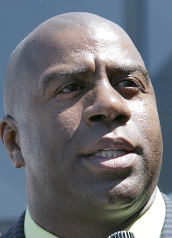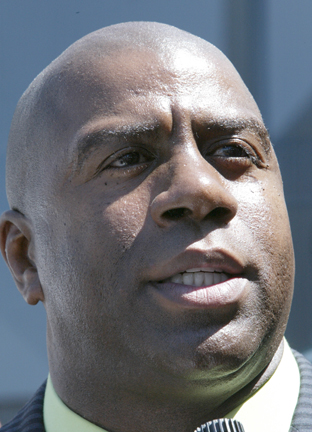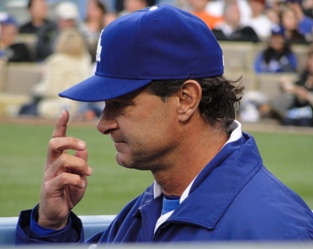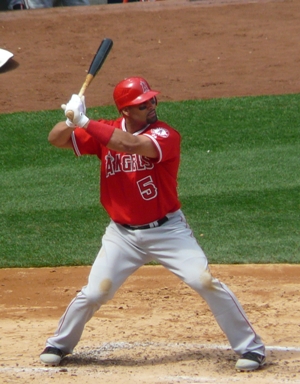
By Derek Rosenfeld
Back in August 2012, I looked at the recent phenomenon of the “pile-on” team, where multiple superstar players jump to one team simultaneously in hopes of creating a superpower-type organization that crushes “normal” teams on its way to a presumably easy path to a championship.
While the pile-on Miami Heat was sealing its second consecutive championship, the pile-on Los Angeles (LA) Lakers sat at home after a first-round exit that saw its superstar guard Kobe Bryant contemplate his retirement after an injury during the Lakers’ own failed attempt to ape the Heat’s success. Instead of leading the team to this assumed success, the preseason additions of free agent stars Dwight Howard and Steve Nash created a dysfunctional team that got initial Coach Mike Brown fired just three games into the season, and which saw new Head Coach Mike D’Antoni subsequently fare little better in his attempts to create an actual working basketball team.
The latest big-budget pile-on teams to watch their fortunes take a nosedive are the Lakers’ crosstown brethren Los Angeles Dodgers and Los Angeles Angels of Anaheim (LAA). The Dodgers currently sit in last place in the National League West with a 38-43 record, four games back of the first-place Arizona Diamondbacks, while the equally enigmatic Angels are eerily similar at 39-43, with only the woeful, AAA-like Houston Astros keeping them out of the American League West cellar.
 Hope was in the air for the Dodgers in March 2012 when much reviled owner Frank McCourt sold the team to the Guggenheim Partners financial group, headed by Lakers legend Magic Johnson (left) and movie executive Peter Gruber, after a long, contentious love-triangle-type scenario played out in the media that featured McCourt’s divorce proceedings, the team’s financial troubles, and the team’s fans. The Dodgers were in a huge financial hole, but Johnson and his backers swooped in and made McCourt an offer he couldn’t refuse: $2.15 billion in cash (way more than the actual value of the franchise).
Hope was in the air for the Dodgers in March 2012 when much reviled owner Frank McCourt sold the team to the Guggenheim Partners financial group, headed by Lakers legend Magic Johnson (left) and movie executive Peter Gruber, after a long, contentious love-triangle-type scenario played out in the media that featured McCourt’s divorce proceedings, the team’s financial troubles, and the team’s fans. The Dodgers were in a huge financial hole, but Johnson and his backers swooped in and made McCourt an offer he couldn’t refuse: $2.15 billion in cash (way more than the actual value of the franchise).
Then, on August 25, 2012, in an attempt by the new ownership to gain instant credibility and put the National League on notice, the team pulled off one of the biggest blockbuster deals in baseball history when it acquired expensive Boston Red Sox headaches Josh Beckett, Carl Crawford, and Adrian Gonzalez (with utility man Nick Punto) in a massive three-team deal that added tens of millions of dollars to the payroll. Add to those players the big offseason free agent signing of coveted pitcher Zack Greinke and another late-season trade that brought in to the fold former perennial MVP candidate Shortstop Hanley Ramirez, and you had the greatest pile-on baseball team since, well, ever.
And there, in the end, was the smiling visage of Magic, the consummate winner, looking like he just purchased a World Series ring to add to his NBA trophy case. Because adding a slew of the most expensive players in the sport to a team automatically guarantees success, right?
 Even in the game of basketball, where Magic was a genius, a pile-on team is more likely to succeed than any other sport because it is played by the fewest number of players. And perhaps Magic thought this logic would also apply to baseball. However, as soon as the ink dried on all of these transactions, Manager Don Mattingly (right) was almost immediately placed on the hot seat—win with this high-priced group or else!
Even in the game of basketball, where Magic was a genius, a pile-on team is more likely to succeed than any other sport because it is played by the fewest number of players. And perhaps Magic thought this logic would also apply to baseball. However, as soon as the ink dried on all of these transactions, Manager Don Mattingly (right) was almost immediately placed on the hot seat—win with this high-priced group or else!
On May 22, during a recent losing streak where his job was constantly being taken to task, a frustrated Mattingly made clear he knew what the problem was with his team. Talking to the Orange County Register, he said the following:
“There has to be a mixture of competitiveness. It’s not, ‘Let’s put an All-Star team together and the All-Star team wins.'”
He continued, “It’s finding that balance of a team that has a little bit of grit and will fight you. And also having the talent to go with it.”1
 As it were, subsequent injuries to Greinke, Beckett (who is now out for the season), Crawford, and homegrown star Matt Kemp as well as the ineffectiveness of star outfielder Andre Ethier have exposed the team as being much less than the sum of its parts, which is actually typical for a team so cynically built.
As it were, subsequent injuries to Greinke, Beckett (who is now out for the season), Crawford, and homegrown star Matt Kemp as well as the ineffectiveness of star outfielder Andre Ethier have exposed the team as being much less than the sum of its parts, which is actually typical for a team so cynically built.
Despite all of this turmoil, hope may have arrived for the Dodgers in the form of Yusiel Puig (right), a 22-year-old Cuban defector who the team signed to a seven-year, $42 million contract in June 2012 and who has made an immediate, near historical impact since his call-up to the bigs on June 2 of this year. Still, Mattingly’s job remains in jeopardy and their stars continue to underachieve, forcing the Dodgers to dig themselves out of an early-season hole from which it may never fully crawl out of. It was more proof that winning comes from within the organization, not outside of it.
Heading down the state’s I-5, about 30 miles southeast of Chavez Ravine, the “other” LA team is going through similar tough times with a similarly massive payroll and high expectations from its free agent binging. The Angels have been one of the most successful American League teams of the past decade, winning the World Series in 2002 and being a regular playoff contender nearly every year since Mike Scioscia took over as the team’s manager in 2000; the team has not finished lower than third in that time span.
When popular owner Arte Moreno bought the Angels in 2003, he slowly but surely began carrying the mantle of the late New York Yankees Owner George Steinbrenner. Never afraid to put his money where his mouth is, Moreno immediately slashed ticket and concession prices while also going after the highest-priced players on the market, which included Valdimir Guerrero, Gary Mathews Jr., Mark Teixeira, and Torii Hunter. He also changed the name of the team (to the chagrin of its fans and the city of Anaheim). However, through these dealings, Moreno nearly doubled the value of the team just three years after its purchase.
 Moreno shocked the baseball world by signing free agents Albert Pujols (10 years, $254 million) (left) and C.J. Wilson (five years, $75 million) after the 2011 season, placing extraordinarily high expectations on the team going into 2012. However, Pujols got off to what was by far the worst start of his career (although he eventually became more “Pujols-like” in the season’s second half), and a trade with the Milwaukee Brewers for Greinke didn’t pan out as was initially hoped (he eventually signed with the Dodgers, as stated above), while the shrewdly-build Oakland A’s, with nary a big name on the roster, stunned the American League West and left the Angels on the outside of the playoffs looking in. So, it was time for Moreno to make another splash.
Moreno shocked the baseball world by signing free agents Albert Pujols (10 years, $254 million) (left) and C.J. Wilson (five years, $75 million) after the 2011 season, placing extraordinarily high expectations on the team going into 2012. However, Pujols got off to what was by far the worst start of his career (although he eventually became more “Pujols-like” in the season’s second half), and a trade with the Milwaukee Brewers for Greinke didn’t pan out as was initially hoped (he eventually signed with the Dodgers, as stated above), while the shrewdly-build Oakland A’s, with nary a big name on the roster, stunned the American League West and left the Angels on the outside of the playoffs looking in. So, it was time for Moreno to make another splash.
 Enter Josh Hamilton (right).
Enter Josh Hamilton (right).
The Texas Rangers MVP was one of the most explosive players in the game when he fell out of favor with the organization and its fans late last season despite putting up huge first-half numbers; a combination of poor second-half play and off-the-field concerns turned Hamilton into a pariah and made him expendable. Moreno jumped at the chance to add yet another dominating bat to his already formidable lineup, snagging Hamilton for five years and $133 million.
Once again, the results of this pile-on all-star baseball team are mixed. To say the Angels have underachieved is an understatement. Despite recently sweeping the Tigers in Detroit, the team remains nine games back of the Rangers through a combination of Hamilton’s abysmal play (a batting line of .223 BA/.283 on-base percentage/.392 slugging percentage); the potentially damaging plantar fasciitis Pujols has contracted, affecting his own numbers; and weak pitching. Meanwhile, the Rangers and St. Louis Cardinals, the respective teams each player left, are comfortably in playoff contention, each forging ahead for another World Series title run.
Although the NBA just witnessed another pile-on team hoist another championship, the rules change when this concept is put into practice in sports with a higher number of participants. It rarely works in baseball, as history has shown over the past decade. (One argument made against this would be the 2009 Yankees; however, that team boasted a surprisingly large number of homegrown players.) Some teams get wise to the concept, as evidenced by the numerous relatively medium-sized contracts given to young players with little major league service time (i.e., Evan Longoria, Jay Bruce, Paul Goldschmidt, Elvis Andrus).
There is still plenty of time for both teams to turn their seasons around, as evidenced by their recent winning streaks; however, little of that could be attributable to the players whose contracts each team took on. As it remains, the 2013 Dodgers and Angels may eventually be seen as cautionary tales. As fan attendance decreases around the league, so will the size and lengths of contracts for players like Pujols, Hamilton, and many others who will sooner or later come to symbolize the phrase “addition by subtraction.”
Photos found on Wikimedia Commons courtesy of, from top to bottom, Rafael Amado Deras, Cbl62, Ron Reiring, Marianne O’Leary, and Keith Allison.
ENDNOTES
- www.usatoday.com/story/sports/mlb/dodgers/2013/05/22/don-mattingly-dodgers-manager-grit-talent-mental-toughness/2351061.
 Derek Rosenfeld is an associate editor for Fire Engineering. He has coached baseball at the collegiate level for nine seasons, including stints at New Jersey’s Bloomfield College, Bergen Community College, and Ramapo College. He has also been an infielder in several highly competetive semipro baseball leagues throughout the New York tri-state area.
Derek Rosenfeld is an associate editor for Fire Engineering. He has coached baseball at the collegiate level for nine seasons, including stints at New Jersey’s Bloomfield College, Bergen Community College, and Ramapo College. He has also been an infielder in several highly competetive semipro baseball leagues throughout the New York tri-state area.
During the mid-90s, Rosenfeld was a three-year starter at second base for the Ramapo College baseball team in Mahwah, New Jersey, where he earned all-New Jersey Athletic Conference honors and was a two-time New Jersey Collegiate Baseball Association (NJCBA) all-star selection. He was named MVP of the 1997 NJCBA All-Star Game. He has a bachelor of art’s degree in communications from Ramapo College.


